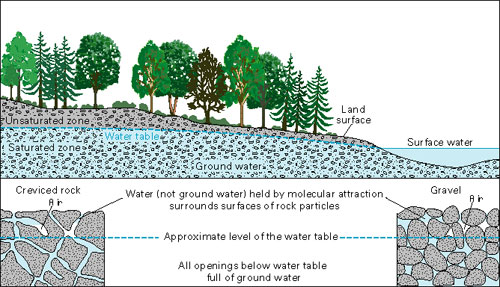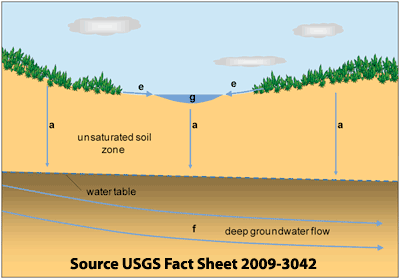Share:
HYDRAULIC FRACTURING & GROUNDWATER PROTECTION
Nearly half of the U.S. population relies on groundwater as their primary source of drinking water. In rural areas, this figure approaches 95%. It is easy to see from these figures that groundwater is an important source of water that should be protected. But what exactly is groundwater?

Groundwater is the water that is held within the interconnected openings of saturated rock beneath the land surface in much the same way as water would be held in a bowl full of marbles. Although the marbles would fill the bowl, there would be spaces between the marbles. These spaces can hold fluid. As shown in the diagram above, this is how water exists in the subsurface.
On the graphic below, the hydrologic cycle ‡ shows that when rain falls to the ground, some water flows along the land surface to streams or lakes (e) and (g), some water evaporates into the atmosphere, some is taken up by plants, and some seeps into the ground.

As water begins to seep into the ground, it enters a zone (a) that contains both water and air, referred to as the unsaturated zone or vadose zone. The upper part of this zone, known as the root zone or soil zone, supports plant growth and is crisscrossed by living roots, holes left by decayed roots, and animal and worm burrows.
Below the root zone lies a capillary fringe which results from the attraction between water and rocks. As a result of this attraction, water clings as a film on the surface of rock particles.
Water moves through the unsaturated zone into the saturated zone (f), where all the interconnected openings between rock particles are filled with water. It is within this saturated zone that the term “groundwater” is correctly applied. Groundwater is held in aquifers which are discussed in the following sections.
Groundwater myths:
- Groundwater moves rapidly.
- Groundwater migrates thousands of miles.
- There is no relationship between groundwater and surface water.
- Groundwater removed from the earth is never returned.
- Groundwater is mysterious and occult.
- Groundwater is not a significant source of water supply.
The diagram below shows how groundwater is held in the spaces between rock particles.

The Miriam Webster dictionary defines an aquifer as a “water-bearing stratum of permeable rock, sand, or gravel.” Aquifers may contain fresh, brackish or salty water in volumes ranging from minor to large enough to serve a public water system.
Aquifers that provide sustainable fresh groundwater to urban areas and for agriculture are usually located at depths of less than a few hundred feet below the ground surface.
Gravity is the dominant driving force in groundwater movement in aquifers that are not bounded above and below by impermeable rock. This is called an unconfined aquifer. Under natural conditions, groundwater moves “downhill” until it reaches the land surface at a spring such as the one shown below or through a seep in the side or bottom of a river bed, lake, wetland, or other surface water body.
Groundwater can also leave the aquifer via the pumping of a well. The process of groundwater outflowing into a surface water body or leaving the aquifer through pumping is called discharge.
Many rivers, lakes, and wetlands rely heavily on groundwater discharge as a source of water. During times of low precipitation, these bodies of water would not contain any water at all if it were not for groundwater discharge. It is important to note that because of discharge, contaminants in groundwater can flow into surface water bodies. This process can make the removal of contamination very complex.
Confined aquifers are bounded above and below by impermeable rock. The driving force of groundwater movement in confined aquifers is pressure, rather than gravity.
When the intersection between the aquifer and the land’s surface is natural, the pathway is called a spring. If discharge occurs through a well, that well is a flowing or artesian well.
You can also get more information about aquifers on the U.S. Geological Survey website.